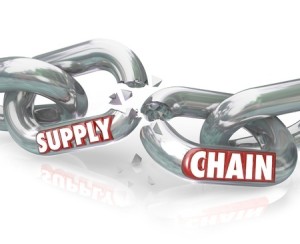 Many businesses share common management concerns including potential supply chain disruptions. These common supply chain threats include extreme weather like hurricanes or tornadoes, or natural disasters like earthquakes and floods. Other kinds of disruptions like supplier breaks, labor issues and pricing risks, are perhaps less dramatic, but hold the same potential for damage. For every business, the type and ultimate impact of supply chain disruptions will vary. There are several threats to a business”s supply chain, especially if they rely on transportation.
Many businesses share common management concerns including potential supply chain disruptions. These common supply chain threats include extreme weather like hurricanes or tornadoes, or natural disasters like earthquakes and floods. Other kinds of disruptions like supplier breaks, labor issues and pricing risks, are perhaps less dramatic, but hold the same potential for damage. For every business, the type and ultimate impact of supply chain disruptions will vary. There are several threats to a business”s supply chain, especially if they rely on transportation.
Supplier Breaks
Any manager waiting for a truckload of raw materials originating in a hurricane zone along the Gulf knows that unforeseen disruptions are costly and can potentially put their business at risk. Supplier breaks can arise for a variety of reasons.
Climate change and environmental damage continue to cause supplier breaks because they can lead to swings in the cost of commodities and other materials prices, which can affect your bottom line. For example, changes in climate led to a reduction in grain crops in Eastern Europe, leaving many food manufacturers forced to increase prices to cover the drop in supply and subsequent increase in price. Unanticipated events like explosions in warehouses, business failures, or new regulations can end in supplier breaks too.
Labour Issues
Within the United States, many businesses report that labour problems continue to be a considerable supply chain disruption. Labor disputes in particular, like prolonged strikes, or wage hikes that can translate into increased costs of supplies and both can affect the supply chain and ultimately your business’s bottom line.
Within emerging markets countries, their labor problems can also affect the supply chain when suppliers must address, for example, human rights violations, labor law violations with child labor and unsafe working conditions. Those costs are passed on with the price of the products and ultimately to your business.
Pricing Risks
A third major risk area concerns prices. Price volatility would head the list of supply chain disruption concerns for many companies. Price risks include economic highs and lows that could threaten your business. Of course, all businesses with global supply chains are especially vulnerable to a rise in transportation prices stemming from volatile oil and gas prices.
Emerging markets countries, like China, pose potential supply chain disruptions because first, if they are your business competition, they can produce the same goods and services for significantly lower input costs for wages as well as materials. Emerging market countries can oftentimes take advantage of lower costs because of weaker regulatory compliance, like with with costly compliance procedures such as pollution controls.
Further, the risk posed from emerging market countries is unstable because it includes political risks. As companies move their operations around Southeast Asian countries, for example, additional problems like inflation can cause political instability that will further threaten supply chains.
A second pricing risk arises because more companies rely on at least part of their materials from international locations, especially emerging markets. Emerging markets prices also fluctuate countries can affect your business because as suppliers in your supply chain, they often fluctuations in their product and transportation costs.
Supply chain disruptions can arise for diverse reasons, from natural disasters to labor disputes. Every business must be aware of potential disruptions so that they are managed to minimize their impact.


